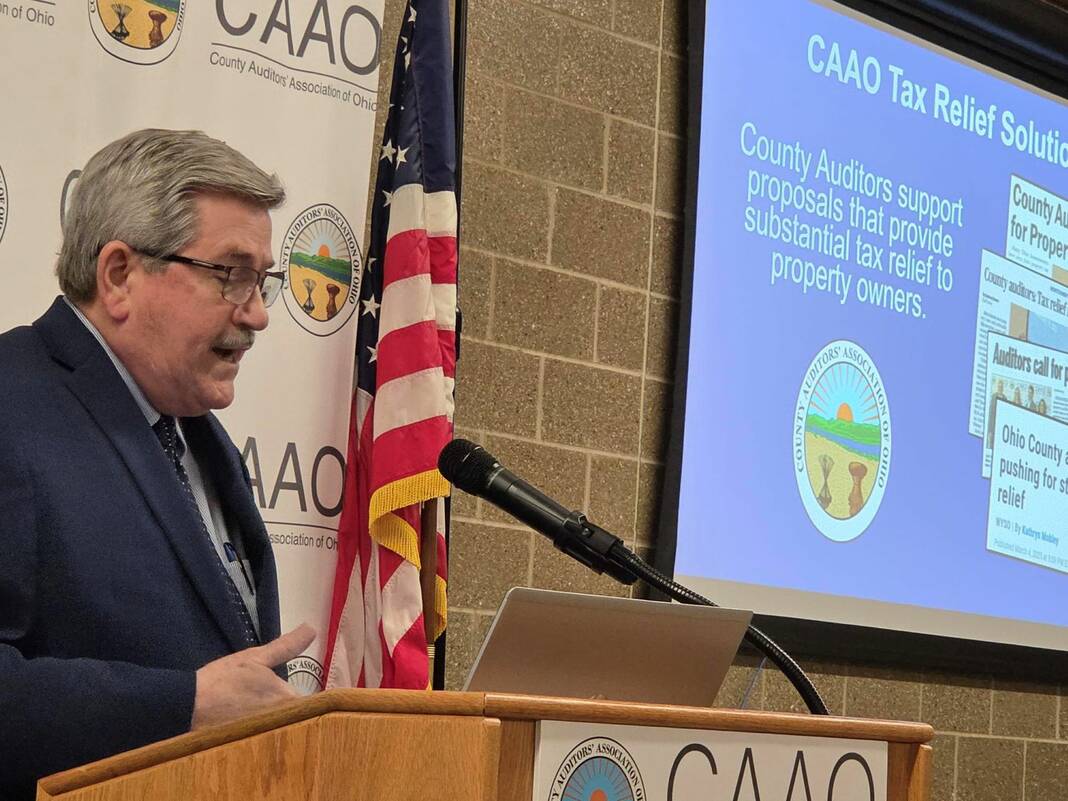
Karl Keith, auditor in Montgomery County, spoke at the information session hosted by the County Auditors’ Association of Ohio.
It wouldn’t be difficult to solve the property tax issue facing Ohioans, but the state’s legislature needs to get on board.
Members of the County Auditors’ Association of Ohio held an informational session Wednesday to explain four easy steps to secure tax relief for property owners.
Property reappraisals – which are ongoing in the state and were completed in Wood County in 2023 – led to higher property values and higher taxes.
People tend to leave the room when the topic of property taxes comes up, said Wood County Auditor Matthew Oestreich.
He quoted President William G. Harding: “I can’t make a damn thing out of this tax problem.”
While there is no silver bullet, we do have suggestions, he said.
Auditors are proposing an expansion of the homestead program, an elimination of non-business credit and expansion of the owner occupancy credit, limiting the growth of revenue received by school districts on the 20-mill floor, and targeted relief.
Karl Keith, auditor in Montgomery County, said there was a common-sense approach that can be done immediately and have an immediate impact.
Reevaluations caused the property values in Northwest Ohio to increase by 30%, he said. The robust real estate market has caused the U.S. median home value to increase by 67% in the last five years,
“We have all been experiencing these types of double digit increases for some time,” he said.
And that has tax implications, he said.
“We do not have a value problem; we have a taxation problem,” he said
A Joint Committee on Property Tax Review and Reform met for one year, had a lot of ideas, and recommended nothing.
As auditors, we’ve been studying this issue and trying to come up with ideas, Keith said.
It was the third idea — to limit the growth in revenues received by school districts at the 20-mill floor — that received the most attention.
Until the 20-mill floor is fixed, taxpayers won’t see any relief, said Warren County Auditor Matt Nolan.
School districts collect a portion of the 10 inside mills – which is not voted on by taxpayers and is not affected by House Bill 920, meaning 10 mills will always be collected.
All outside millage is approved by voters.
When those are added and equal more than 20 mills, HB 920 takes effect and residents will see little impact on taxes, according to Oestreich.
HB 920 was passed in 1976 to prevent inflation from increasing property taxes. So, as your home values increased, the number of mills collected was reduced in order to collect the same tax amount that was originally voted on by the taxpayers.
Oestreich explained that, for Bowling Green City Schools, the 2023 reevaluation generated $12.94 million, which was a 2.32-mill unvoted tax increase that is adding $1.5 million annually to the district’s general fund.
A fix to the 20-mill floor will provide the most relief to Ohioans, Nolan said.
For those school districts at the 20-mill floor, a 30% property value increase results in a 15% tax increase. For those schools above 20 mills, a 30% property value increase will result in a tax increase of 5%.
All but three school districts in Wood County – Lake, Rossford and Northwood – are at the 20-mill floor, Oestreich said.
“The fix is not that hard,” Nolan said.
All we want to do is go back and have HB 920 do what it should, he said.
School funding won’t be cut; they will still receive an inflationary increase but not the jump in taxes due to a reevaluation, he said.
The 20-mill floor only applies to school districts.
“I think we’re trying to find a balance,” Oestreich said. “We want to help taxpayers, and school districts will get small growth over time but not these windfall gains. If they need something, they’re going to have to ask the taxpayer for it.”
Nolan said since January, there have been 19 bills introduced in Ohio addressing property taxes, but if they don’t address the 20-mill floor, they are not tax relief, he said.
He said legislators don’t want to address the issue because they don’t understand it.
He said he hasn’t heard from legislators that it’s a terrible idea, the response is usually we don’t want to touch that.
School districts have testified they are afraid they won’t get as much money and will have to run more levies – to me that is an unacceptable response, Nolan said.
Adhering to the 20-mill floor as proposed does not cut revenue to a single school district; it does reduce future growth, he said.
“We need more people to talk to their legislators,” Nolan said.
Every time we go through a reevaluation, people point out the issue of using property taxes to fund schools was ruled unconstitutional and wasn’t the lottery money supposed to fix funding, said Union County Auditor Andrea Weaver.
“The school funding issue continues to be the elephant in the room,” she said.
Other ideas included:
• Currently under the homestead program, the first $28,000 of property values are exempt from property taxes for those who are 65 and older or permanently disabled or if they have a household adjusted gross income of $40,000 or less.
Due to income restrictions, the number of eligible people has declined, Weaver said.
“You shouldn’t be poverty stricken to qualify for the homestead credit,” Oestreich said. “I personally would like to see the (property tax) amount exempted doubled to over $50,000 and make the income cap at $10,000.”
If both the amount exempted and the income threshold are increased, the most vulnerable Ohioans will be able to stay in their homes, Weaver said.
• Levies passed prior to 2013 currently provide a 10% reduction on all residential and agricultural properties and an additional 2.5% reduction (set in 1979) if the owner resides on the property. These discounts have been diminishing, leading to reduced savings for property owners as new levies have passed.
Eliminating the non-business credit and passing those savings onto homeowners will reduce their tax burden.
“Anything you do there is an immediate savings to anyone who owns property and lives on it,” Nolan said.
• Tax deferrals, income tax credits and abatements also can be designed to protect low- and moderate-income residents.
Weaver said that legislators haven’t heard citizens cry out for property tax relief and haven’t put value on making any changes. Until they realize this is an issue, nothing is going to change.







